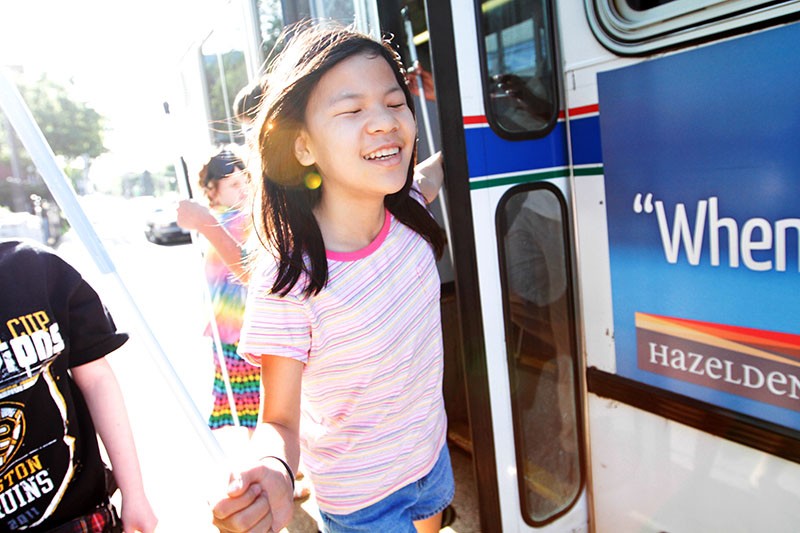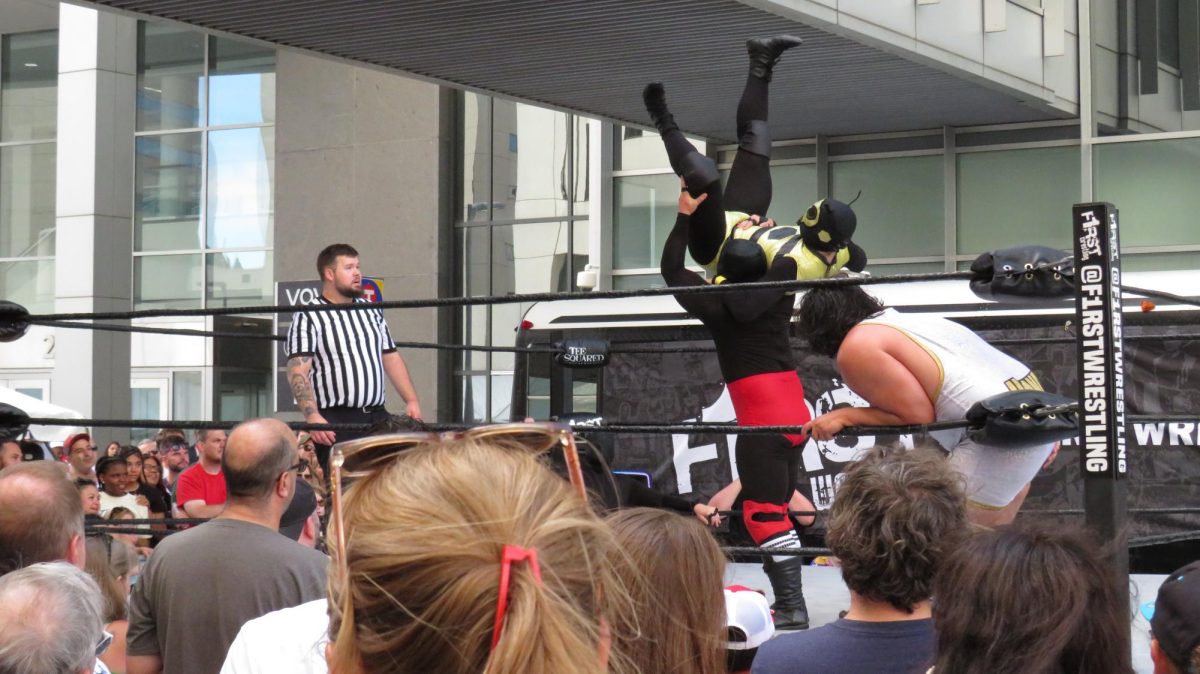Making his way across the University of MinnesotaâÄôs Northrop Mall with a white cane, eyes covered by night shades and wearing a flower in his hair, 12-year-old Ian Moon of Apple Valley, Minn., and his friends âÄî 10 blind or visually impaired kids âÄî drew smiles and stares from students on their way to class and work.
âÄúI can kind of see but I have a tendency to run into poles,âÄù Ian said matter-of-factly.
Middle school students from around the country are in the middle of a three-week summer program that has them sleeping in Comstock Hall and riding the city bus to Blind,Inc., where they take classes in cooking, Braille, âÄúcane-travelâÄù and computers.
On the way to the bus last week, Patrick Barrett, one of the groupâÄôs chaperones, also blind, blasted his whistle four times over the sound of power drilling nearby, signaling that there was an âÄúissueâÄù âÄî the need for an immediate head count of the 10 participants.
âÄúThat whistle kind of sounds like a bird,âÄù one participant, 9-year-old Brandon Pickle, responded.
Barrett shouted above the din of construction: âÄúWeâÄôre losing people left and right âÄî literally.âÄù After a quick count, chattering resumed and the phalanx mobilized once more.
The purpose of The Buddy Program, Blind Inc.âÄôs camp for kids ages 9 to 13, is to teach blind and partially-sighted youth to have fun and be independent without using their sight. During the program, partially-sighted youth wear night shades so they can fully immerse themselves in the training.
Staying away from home on a college campus adds challenges and extra learning opportunities like doing laundry, dealing with construction detours and navigating unfamiliar places.
âÄúWhether youâÄôre sighted or blind, you have to problem solve,âÄù said Charlene Guggisberg, director of the Buddy program.
Fighting doubts
Ten-year-old Anna Walker, a Buddy Program participant from Pennsylvania, said well-intentioned bus passengers have asked elderly people to give up their seats for her when they saw she was blind.
âÄúI donâÄôt really like it when people try to do things for me,âÄù she said. âÄúI like to do things by myself.âÄù
Other participants must prove wrong the doubts and fears strangers have about their safety and competence in the âÄúreal world.âÄù
Muzamil Yahya, a counselor for the Buddy Program who teaches cane travel, graduated from Blind Inc.âÄôs adult program in 2009 then came back to teach.
âÄúI like to be with kids,âÄù he said.
Yahya worked with Megan Shermer, 9, from Springfield, Mo., on Thursday morning, showing her how to find the side of a curb with her cane then listen to the pattern of traffic. Each time the light changed, the perpendicular cars stopped moving and the parallel traffic started whooshing past, indicating it was safe to walk.
âÄúKeep listening,âÄù Yahya told Megan, ignoring a frantic, agitated pedestrian who yelled, âÄúDonâÄôt go!âÄù and attempted to stop oncoming traffic for them.
Aundrayah Shermer, MeganâÄôs mother, grew up with blind parents and has high expectations for the blind and visually-impaired. ThatâÄôs part of her job as a blindness skills specialist through Missouri State University. While a number of summer programs for blind youth exist, the common age for a blind child to start is about 14 years old, Shermer said. Knowing that Megan was ready and excited to learn, the Shermers went searching out of state.
Their local chapter of the National Federation of the Blind also footed the program fee of $250 so the Shermers only had to buy the plane ticket. The program fee is low because of grant support.
âÄúI wanted Megan to be exposed to the big city, where she has access to the things she needs, like mass transportation,âÄù Shermer said of her daughter.
âÄúShe can do anything she wants. I needed her to see that from other blind people,âÄù Shermer said.
Katie Fritz, 12, from Wisconsin, has attended the Buddy Program twice before. Fritz said her computer and Braille skills are pretty good, but sheâÄôs excited to learn cooking and other home management abilities. At home, Fritz can wash dishes and wipe counters, but she said other chores, like sweeping, are harder.
âÄúI have to remember where the pile is and not step in it,âÄù she said.
âÄòHard loveâÄô
George Wurtzel teaches âÄúindustrial artsâÄù in the basement of Blind Inc.âÄôs home, an old south Minneapolis mansion. In WurtzelâÄôs class, students work with wood. His workshop, full of sawdust and power tools, is similar to other craftsmenâÄôs spaces âÄî except Wurtzel and his students have no need to turn on the lights.
In the pitch black, he and his students make bird houses and wooden toys.
Wurtzel said that by having students with partial vision work in total darkness, he teaches them to operate the tools and machines more safely than if they were using the little eyesight they have.
âÄúWeâÄôre kind of hard love here,âÄù Wurtzel said. âÄúWeâÄôll let you fail at something many, many times until you understand the task.âÄù
Blind staff members who are professionals teach students in the Buddy Program that some activities can be performed most efficiently if the students learn non-visual techniques.
Mary Ruff, an occupational therapist in the Fairview clinics system who works at the University of MinnesotaâÄôs Eye Clinic, said relying on eyes isnâÄôt always the best option, even though she teaches people how to use their partial vision.
She has referred patients to State Services for the Blind, which connects them with Blind Inc., and says the non-visual training there is complementary to her work, not adversarial. Her job is not to correct vision but to show people how to maximize their function.
Buddy Program counselor Kayde Rieken, blind since birth, teaches kids how to use computers with âÄúscreen readersâÄù âÄî software that verbalizes everything that sighted people would see on a monitor.
The computers at Blind Inc. look odd âÄî just keyboards and speakers on top of the computer hardware, but without monitors. By pressing the arrows and keyboard commands, students can use the Internet and create documents.
All Apple products, including RiekenâÄôs iPhone, come with a screen reader. RiekenâÄôs phone, which dictates to her at five times the normal rate of human speech, also has convenient features like a currency reader that uses the camera on the iPhone to tell her what kind of bill sheâÄôs holding.
Katie Fritz, who lost her eyesight at age 4 because the orphanage where she was living didnâÄôt have the resources to provide treatment, said the training at Blind Inc. isnâÄôt hard, but it can sap oneâÄôs energy.
You have to want to learn, Fritz said, but doing it with friends and pizza, like the kids did their first night in Comstock Hall, is more fun.
âÄúSometimes itâÄôs rowdy. Sometimes itâÄôs normal,âÄù she said.








